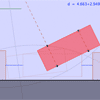mathematics of parking
back to math nerdiness page or talljerome home

| | mathematics of parkingback to math nerdiness page or talljerome home |  |
The Geometry of Perfect Parking - Prof. Simon Blackburn's pageWeb page by English math professor Simon Blackburn, whose report on the math of parallel parking was the subject of the news reports that sparked my interest. Includes the actual report which I din't even notice until almost a year later! |
Parallel Parking - Attempt 1 (US customary) or Attempt1 (Metric)Before finding Dr. Blackburn's report, I simply enjoyed the challenge of using just his formula to deduce what geometry he used and assumptions he made. The formula was included in one of the news reports without any supporting diagrams. |
Parallel Parking - Attempt 2 (US customary)In trying to come up with my own less-conservative formula for parallel parking, I first created a computer model in which the car reverses along an angled line to the curb, turns hard toward the curb, and pulls forward until parallel. Before proceding to derive the formula, I determined (with input from colleagues) that reversing straignt back does not accurately reflect how people parallel park. |
Parallel Parking - Attempt 3a/3b (US customary) or Attempt 3a/3b (Metric)For attempt "3a": I settled on the model that real-world parallel parking involves backing up along an arc with steering wheel turned hard to one direction and then pulling forward along an arc with steering wheel turned hard in the other direction. The mathematics got ugly quite quickly, but eventually the "sine of a difference" trigonometry formula provided a breakthrough towards an algebraic solution. The "3b" follow-up addresses how much lateral displacement may be gained through successive back and forth motions. |
Perpendicular Parking (US customary and Metric)Reviving my interest in the parallel parking from almost a year prior, I developed a computer model and set of formulas for the minimum distance needed to park perpendicular to the initial path of travel (with only forward motion). According to comments in Professor Blackburn's report, the optimal geometry for perpendicular parking would involve a more complicated curve called a "tractrix." I was initially inclined to agree, although I now suspect that following a tractrix given real-world parameters would require an unrealistically-tight turning radius. I belive my model/formula provides a reasonable ballpark estimate of minimum space requirements, but I'm not prepared to argue that it gives the absolute optimal solution. |
New York Times articleFrom “The Year In Ideas” section on Sunday, December 19, 2010, a few seconds of nerd fame! |